Aaron Lubrick was part of a two-person new member show during February at the co-op gallery Pyro, housed on Washington Street in Louisville’s up-and-coming Butchertown neighborhood. Lubrick shared the exhibition space with Suzanne Sidebottom. Sidebottom’s works are trompe-l’oeil porcelain transferware, smaller but equally as adroit as Richard Shaw’s well-known transferware constructions.
The gallery is a converted ca. 1900 cottage duplex. Meatpacking still persists in the neighborhood, and the gallery was perhaps built as a home for workers at a local abattoir. The galleries are intimate, but the largest room has a wall of glass letting in a lot of natural south light. The installation interspersed the work of the two new members. Lubrick’s paintings were modest easel pictures (mostly 15” by 18” or smaller), with the exception of two large works executed in his studio. All the others were alla prima, wet-on-wet oils done out of doors. So the show was well scaled to its setting. Subjects included Montana and Florida landscapes, still lifes, and family at swimming pools or in the back yard of the artist’s home. In addition, there were nude studies, views of road work in Louisville’s Cherokee Park, and of groups at Big Rock, a popular family outing spot on Beargrass Creek.
The pressure of reality gives these paintings a grit not seen, to my eye, in paintings based on photographs. There is a Scottish word, clarty, which applies to these oils: conventionally the word means dirty or muddy, but by colloquial extension, it applies to foods that are thickly textured or stick to the roof of the mouth. Think peanut butter, for example, or bubble gum. At times Lubrick’s paintings are so clarty as to attain the status of low relief sculptures in impasto. The clarty goo of oil pigments, how they are blended or spread or applied, is the poetry in the mechanics of these works. The artist’s enjoyment of his medium is evident in Montana Landscape. Two fence posts establish the foreground, followed by a browned-out meadow bordering a copse of woods in the middle distance. The background is a ridge of blue mountains topped by a crystalline blue sky and cumulus clouds. Definition to these different spaces is provided by varying brushwork – broad flat passages for the meadow and blue of the sky; writhing, curling loops for the woods; ridged strokes following the contours of the mountains; and punctuating staccato stabs for the clouds. The intensity of the sky blue, enlivened and activated by the white clouds, contrasts with the neutralized hues below. With the surface orchestration of the brushwork, the resulting effect is a startling sense of the clarity of light and atmosphere in the Rockies. The artist has aptly written about “the primal and freeing sensation…the experience of wonderment and astonishment” that can arise from contemplative observation of “a large body of water or a freshly cleared field.”
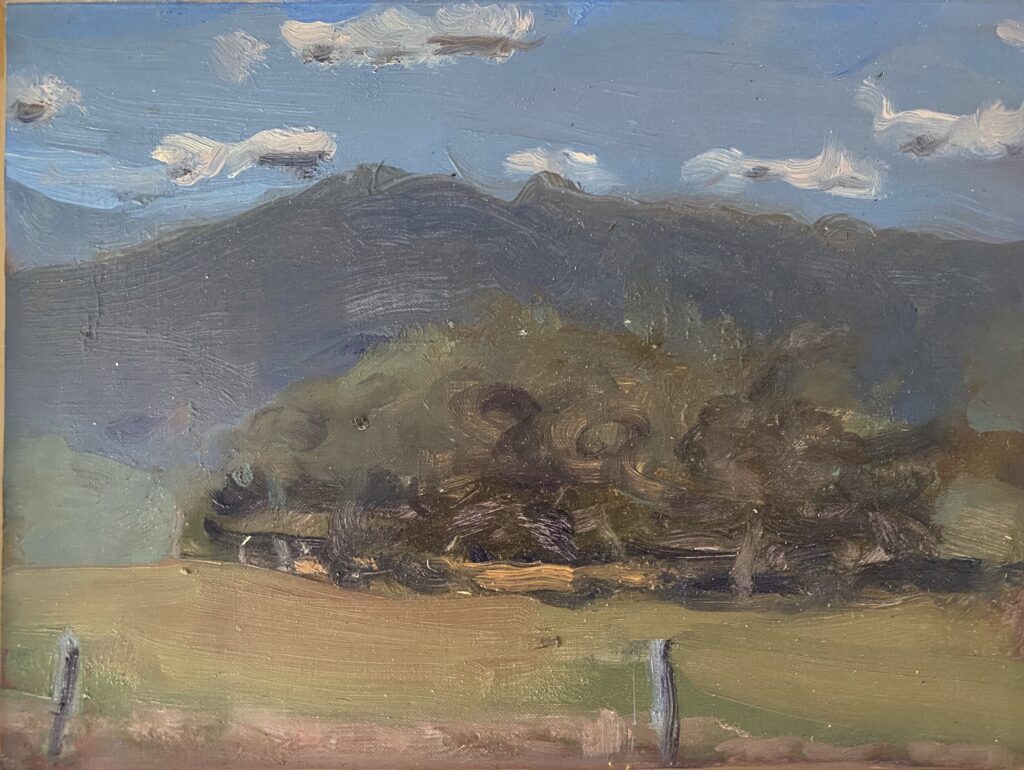
Montana Landscape shows the influence of the early Western painters like Albert Bierstadt and Thomas Moran in its composition and sense of discovery. A regard for art historical precedent is also apparent in Lubrick’s depictions of bathers, an artistic commonplace since Greco-Roman antiquity. But Boys Playing by the Swimming Pool is certainly anti-classical: two of Lubrick’s sons stand beside a condo pool. A reclining chair and table at the lower edge of the picture push the other subjects deeper into a stage-like space of repeated rectangles denoting the orange pavement surrounding the pool, walls rising above scattered chairs and swimming paraphernalia, and the blue-green pool itself.
The glaring sun casts black shadows, most extraordinarily on the boys themselves. They are good examples of Lubrick’s method of conveying three-dimensionality with strong black strokes embracing his figures. The artist dismembers the academic notion of modeling in subtle and gradated variations from white to black. In his improvisatory modeling through blotchy marking, he is also eschewing the common modernist methods of conveying the three-dimensionality of sitters (for example, through repeated outlining, or contrasting the figure with its background). In his highly individual approach to light and shade, Lubrick is recovering a displaced mode of picture-making, and reinventing it in his own terms.
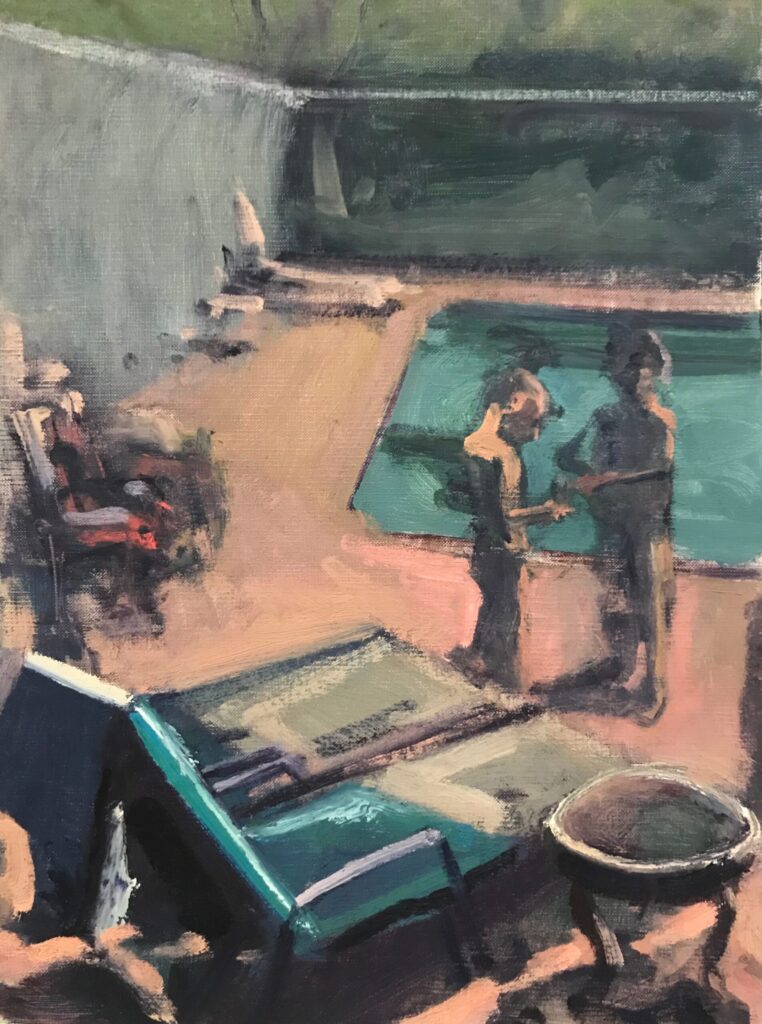
Depicting figures is a means of conveying scale and introducing a narrative element, but also provides a means for injecting a psychological or personal element in the depiction. The artist proclaims, “The faster I paint, the better the work.” A sense of urgency and openness to multiple meanings are apparent in Swimming at Big Rock. Water takes on the colors reflected on its surface and provides pattern with the flow of currents or wind rippling the surface. In this instance, Beargrass Creek is by turns a mottled emerald green, greenish-white, and a smeary blend of green and black. The creek is bordered by white boulders at the top denoted by two or three slashes of the brush and a burnt sienna beach along the lower edge. The palette is portentous, unspecified but possibly sinister. There are three figures: two women in bikinis, standing as if at attention, looking over the water at the left-center of the canvas. To the right is a brilliant bit of bravura brushwork, a child in an orange float in front of a red, white, and blue ball.
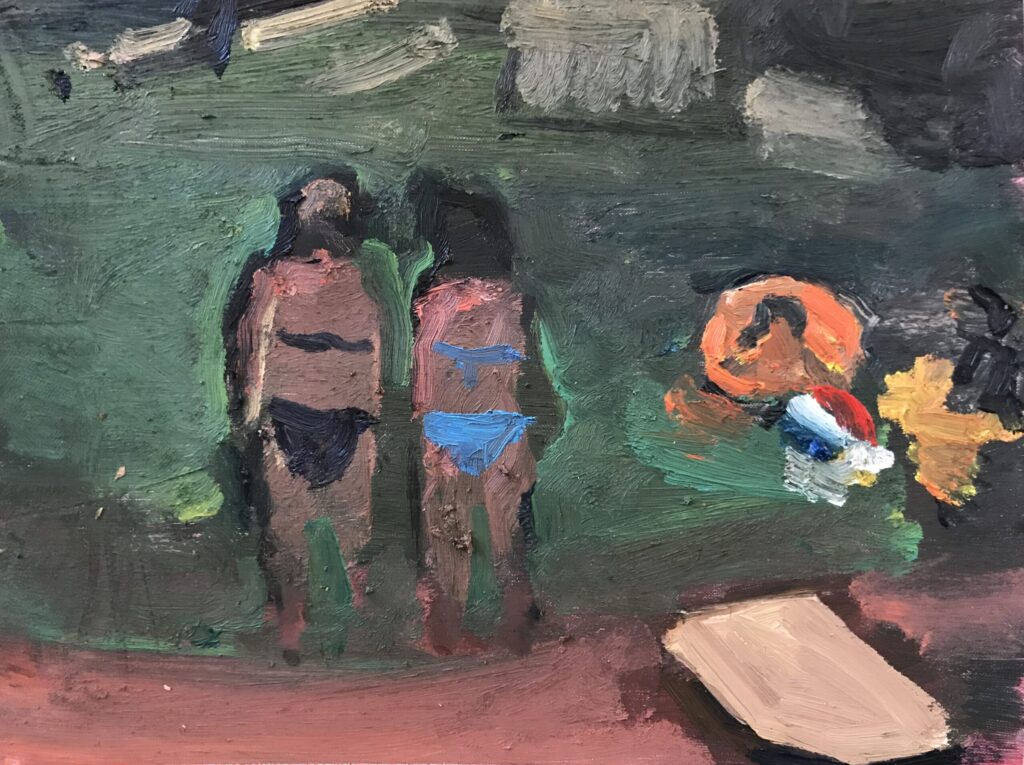
Quizzed on that detail, Lubrick responded, “The red, white, and blue was a beach ball in front of the figure. I believe I quickly painted it in without it actually being in that particular place. I remember needing alternative colors other than the very dominant green water. Also knowing that the red color would really pop or have serious visual contrast. I do remember thinking that it was hard to understand that it was a colorful ball but really appreciating the effectiveness of bold color shapes and feeling no more information was needed to define.”
One of the ironies of Lubrick’s work is his use of a quick and spontaneous plein air process – seemingly perceptual – to summon weighty, contradictory themes. In Swimming at Big Rock there are multiple possibilities: the idyll of enjoying swimming in a natural setting, two women staring ahead as if attempting to see into the future, the promise of youth in the child in the float, and perhaps even an ecological warning about the dicey character of the water quality of Beargrass Creek. The artist notes that “landscape is a malleable metaphor” and his work is “part of a long history of narratives that support contemporary dialogue around the representation of land and identity.”
Aaron Lubrick’s backyard paintings were among the finest of his works in this exhibition. The intimacy of family life is conveyed in the private, confined space where the happenstance of toys, small and large, is framed in by fencing and by surrounding buildings. Lubrick maps this territory in three paintings. Two of the paintings are of his sons playing on a trampoline, notable for the interchange between observation and narration. The paintings provide a platform for seeing the children’s bouncings as if they were enacting feats of mythic proportions. This is especially true of Trampoline and Bouncy Ball, in which the foreground is cast in shadow, dramatizing the leap of the boy seen against a smoky lavender sky. The brilliant red disk of the setting sun is juxtaposed with the boy’s head. A hummingbird feeder to the right suggests an analogy to the boy’s energy. There is an offhand nonchalance to the placement of the sun, as if it had no more significance than the location of the bouncy ball to the right of the trampoline. Significantly, Lubrick includes his studio as a backdrop in all three paintings, possibly a proxy for a self-portrait.
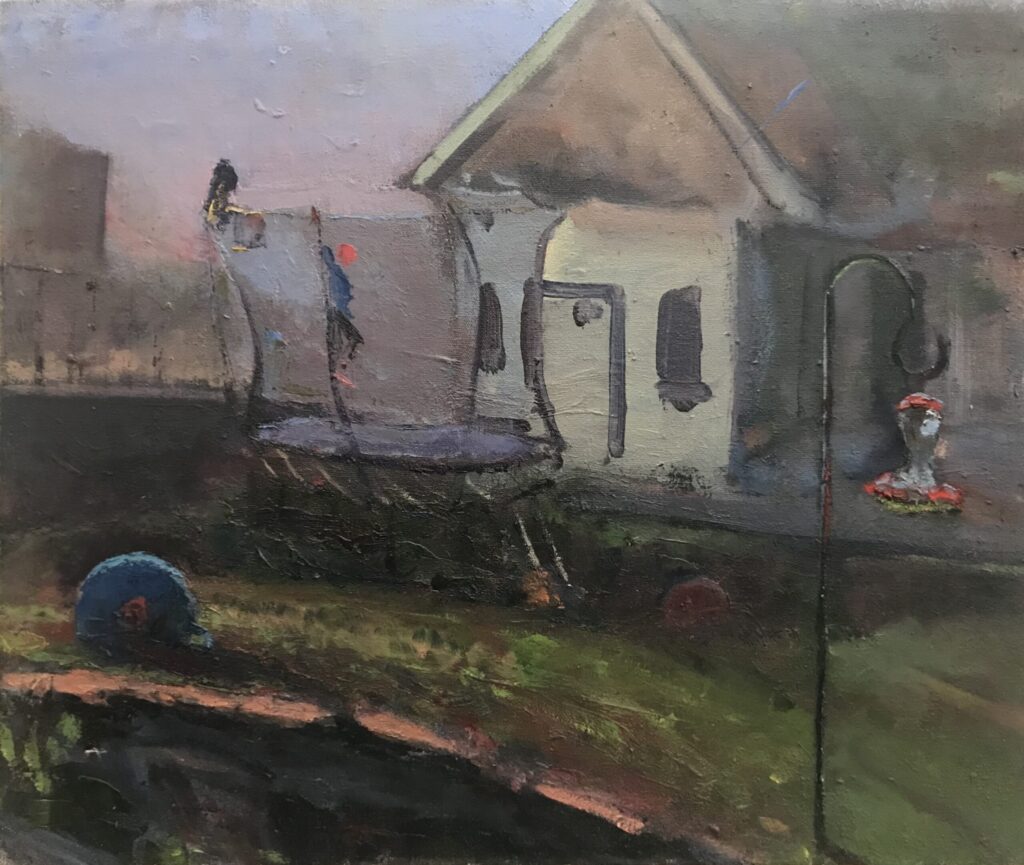
Bounce House Water Slide during Covid was the clearest example in the show of the liminal space Lubrick prospects between observation and abstraction, and his adherence to Giorgio Morandi’s dictum, “nothing is more abstract than reality.” The subject is a simple version of a class of fantastic objects characterized by unlikely sculptural form and brilliantly colored plastic. Beneath a sulfurous night sky the bounce house, like an extraterrestrial spacecraft, is lodged in front of the studio, beside the trampoline and other incidental childhood detritus. The orange arms of the slide are set against the complementary blue of the base: boys in yellow provide a light-dark contrast.
The jolting brilliance of the orange and yellow conveys an air of activity in defiance of the night and the pandemic. The underlying strokes of the brush or swipes of the palette knife offer a secondary structure to the molten, lava-like color. Line, as in the broad strokes delineating the peaked roof of the studio, are place-making markers defining the familial precinct.
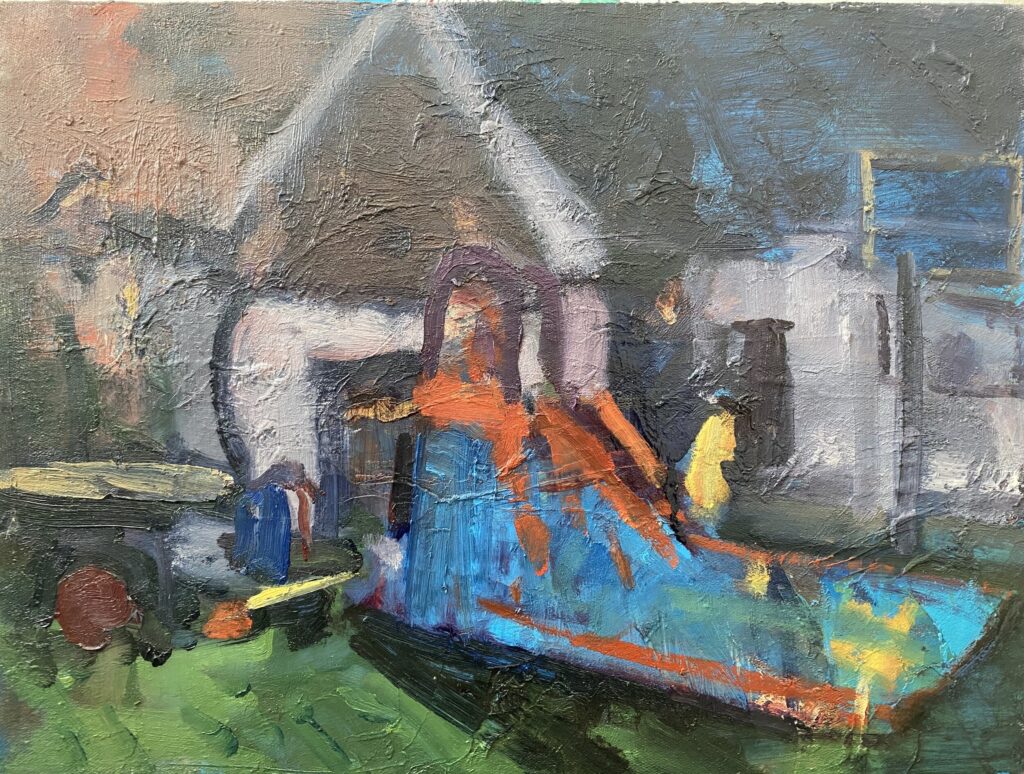
In a previous article for UnderMain (“Studio Visit: Aaron Lubrick”), I proposed that his practice could be roughly described through four aspects or principles: observation, the life of the medium, the artist’s heritage, and private narratives.
Observation: Lubrick’s empirical approach to his visual field is like a jazz musician’s improvisation on a familiar tune, that is, a departure point for further invention.
The Life of the Medium: While painting, Lubrick declares “what happens, happens.” Visual fact is subordinated to a loosened structure that foregrounds discoveries and reverberations during the painting process. Lubrick does not disguise the resistance of the oil medium to realism, but celebrates it.
The Artist’s Heritage: Aaron is engaged in art historical precedents, and in conversation cites Velazquez, William Nicholson, and George Bellows among other painters who were masters of close tonal relations or rugose impasto.
Private Narratives: Finally, the show at Pyro was intriguing in terms of personal meanings. Lubrick is a twin and the recurring depiction of pairs of figures may be germane to the artist’s meditations on that status. A likely subtext to the backyard paintings is the complexities of contemporary parenthood.
The Pyro show was a grand introduction to the artist’s ambitious program and his trust in an instinctual, improvisatory method of artmaking. Most of all, it provided occasions for delight in the many ways the artist gave transcendent importance to scenes conventionally local and familiar.
Top Image: Boys Jumping during Covid. Oil on Panel, 15 x 19.5, 2020.




